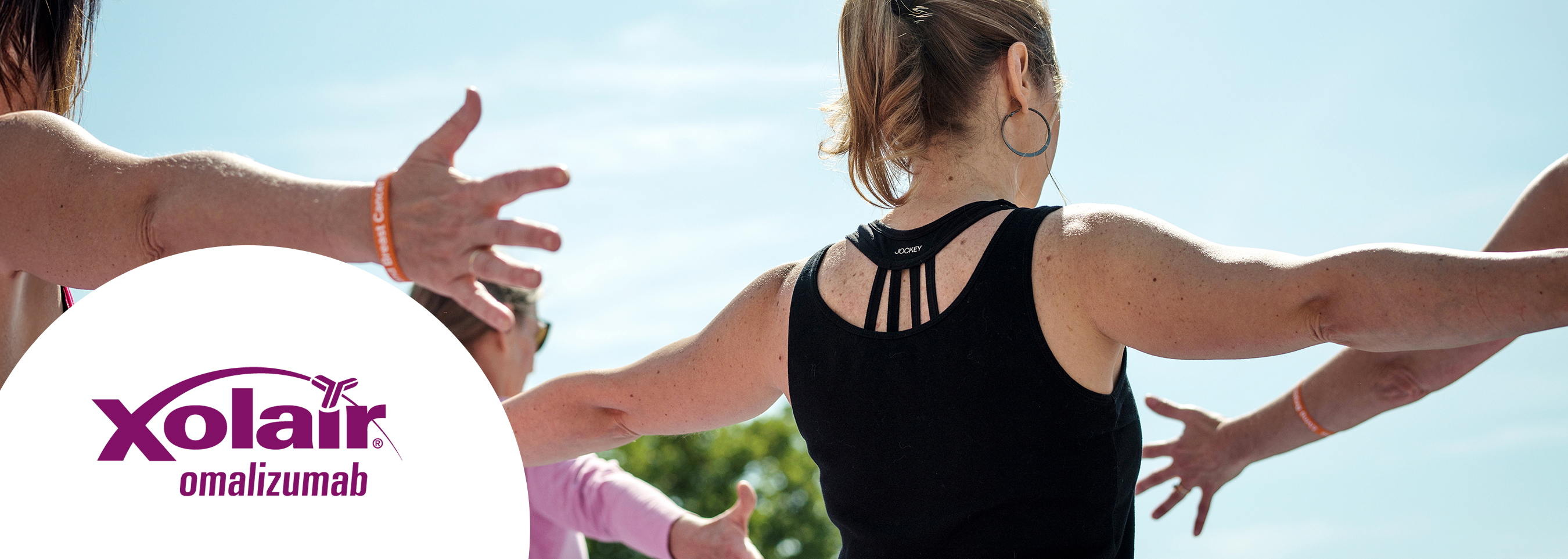

Xolair® (omalizumab) safety profile
Please refer to the Xolair Summary of Product Characteristics (SmPC) for full information on safety, warnings and precautions, special populations, drug interactions and other important considerations.1
Indications:1
Xolair is indicated as add-on therapy for the treatment of chronic spontaneous urticaria (CSU) in adult and adolescent (12 years and above) patients with inadequate response to H1 antihistamine treatment.
The recommended dose of Xolair in patients with chronic spontaneous urticaria is 300 mg by subcutaneous injection every four weeks.1
Xolair has additional therapeutic indications, special warnings and precautions and safety information. Please refer to the Xolair Summary of Product Characteristics (SmPC) for the full therapeutic indication.1
Xolair treatment should be initiated by physicians experienced in the diagnosis and treatment of severe persistent asthma, chronic rhinosinusitis with nasal polyps (CRSwNP) or chronic spontaneous urticaria. Prescribers are advised to periodically reassess the need for continued therapy.
Summary of safety profile for CSU
The safety and tolerability of Xolair were investigated with doses of 75 mg, 150 mg and 300 mg every four weeks* in 975 CSU patients, 242 of whom received placebo. Overall, 733 patients were treated with Xolair for up to 12 weeks and 490 patients for up to 24 weeks. Of those, 412 patients were treated for up to 12 weeks and 333 patients were treated for up to 24 weeks at the 300 mg dose.1
*The recommended dose of Xolair in patients with CSU is 300 mg by subcutaneous injection every 4 weeks.
The adverse reactions (events occurring in ≥1% of patients in any treatment group and ≥2% more frequently in any Xolair treatment group than with placebo (after medical review)) are reported with 300 mg in three pooled Phase III studies.1
The adverse reactions are listed by MedDRA system organ class. Within each system organ class, the adverse reactions are ranked by frequency, with the most frequent reactions listed first. The corresponding frequency category for each adverse reaction is based on the following convention: very common (≥1/10); common (≥1/100 to <1/10); uncommon (≥1/1,000 to <1/100); rare (≥1/10,000 to <1/1000); very rare (<1/10,000) and not known (cannot be estimated from the available data).1
Adverse reactions are from pooled CSU safety database (Day 1 to Week 24) at 300 mg Xolair1
12-week study | Xolair studies 1, 2 and 3 pooled | Frequency category | |
Placebo N=242 | 300 mg N=412 | ||
Infections and infestations | |||
Sinusitis | 5 (2.1%) | 20 (4.9%) | Common |
Nervous system disorders | |||
Headache | 7 (2.9%) | 25 (6.1%) | Common |
Musculoskeletal and connective tissue disorders | |||
Arthralgia | 1 (0.4%) | 12 (2.9%) | Common |
General disorders and administration site conditions | |||
Injection site reaction* | 2 (0.8%) | 11 (2.7%) | Common |
24-week study | Xolair studies 1 and 3 pooled | Frequency category | |
Placebo N=163 | 300 mg N=333 | ||
Infections and infestations | |||
Upper respiratory tract infection | 5 (3.1%) | 19 (5.7%) | Common |
Adapted from Xolair® (omalizumab) Summary of Product Characteristics.1
*Despite not showing a 2% difference from placebo, injection site reactions were included as all cases were assessed causally related to study treatment. In a 48-week study, 81 CSU patients received Xolair 300 mg every 4 weeks. The safety profile of long-term use was similar to the safety profile observed in 24-week studies in CSU.1
Anaphylaxis1
Anaphylactic reactions were rare in clinical trials. However, post-marketing data following a cumulative search in the safety database retrieved a total of 898 anaphylaxis cases. Based on an estimated exposure of 566,923 patient treatment years, this results in a reporting rate of approximately 0.20%.
Arterial thromboembolic events1
In controlled clinical trials and during interim analyses of an observational study, a numerical imbalance of ATE was observed. The definition of the composite endpoint ATE included stroke, transient ischaemic attack, myocardial infarction, unstable angina, and cardiovascular death (including death from unknown cause). In the final analysis of the observational study, the rate of ATE per 1,000 patient-years was 7.52 (115/15,286 patient-years) for Xolair-treated patients and 5.12 (51/9,963 patient-years) for control patients. In a multivariate analysis controlling for available baseline cardiovascular risk factors, the hazard ratio was 1.32 (95% confidence interval 0.91–1.91). In a separate analysis of pooled clinical trials, which included all randomised double-blind, placebo-controlled clinical trials lasting 8 or more weeks, the rate of ATE per 1,000 patient-years was 2.69 (5/1,856 patient years) for Xolair-treated patients and 2.38 (4/1,680 patient-years) for placebo patients (rate ratio 1.13, 95% confidence interval 0.24–5.71).
Platelets1
In clinical trials few patients had platelet counts below the lower limit of the normal laboratory range. Isolated cases of idiopathic thrombocytopenia, including severe cases, have been reported in the post-marketing setting.
Parasitic infections1
In allergic patients at chronic high risk of helminth infection, a placebo-controlled trial showed a slight numerical increase in infection rate with Xolair that was not statistically significant. The course, severity and response to treatment of infections were unaltered.
Systemic lupus erythematosus1
Clinical trial and post-marketing cases of systemic lupus erythematosus have been reported in patients with moderate-to-severe asthma and CSU. The pathogenesis of SLE is not well understood.
For immune system disorder, please see the ‘Special warnings and precautions for use’ section.
Hypersensitivity to the active substance (omalizumab) or to any of the following:1
Arginine hydrochloride
Histidine hydrochloride monohydrate
Histidine
Polysorbate 20
Water for injections

If clinically needed, the use of Xolair may be considered during pregnancy.
A moderate amount of data on pregnant women (between 300 and 1,000 pregnancy outcomes) based on pregnancy registry and post-marketing spontaneous reports, indicates no malformative or foetal/neonatal toxicity
A prospective pregnancy registry study (EXPECT) in 250 pregnant women with asthma exposed to Xolair showed the prevalence of major congenital anomalies was similar (8.1% vs 8.9%) between EXPECT and disease-matched (moderate and severe asthma) patients
The interpretation of data may be impacted due to methodological limitations of the study, including small sample size and non-randomised design
Xolair crosses the placental barrier. However, animal studies do not indicate either direct or indirect harmful effects with respect to reproductive toxicity; therefore, care should be taken when prescribing in pregnancy
Xolair has been associated with age-dependent decreases in blood platelets in non-human primates with a greater relative sensitivity in juvenile animals

If clinically needed, the use of Xolair may be considered in breastfeeding.
Immunoglobulins G are present in human milk and it is therefore expected that Xolair will be present in human milk. Available data in non-human primates have shown excretion of Xolair into milk
Data from the EXPECT study including 154 infants who had been exposed to Xolair during pregnancy and through breastfeeding did not indicate adverse effects in the breastfed infant
The interpretation of data may be impacted due to methodological limitations of the study, including small sample size and non-randomised design
Given orally, immunoglobulin G proteins undergo intestinal proteolysis and have poor bioavailability. No effects on the breastfed newborns/infants are anticipated

There are no human fertility data for Xolair
In specifically designed non-clinical fertility studies in non-human primates, including mating studies, no impairment of male or female fertility was observed following repeated dosing with Xolair up to 75 mg/kg
No genotoxic effects were observed in a separate non-clinical genotoxicity study
Xolair is indicated as add-on therapy for the treatment of chronic spontaneous urticaria in adult and adolescent (12 years and above) patients with inadequate response to H1 antihistamine treatment.1
ASTERIA I:2
The most common adverse events observed in the Xolair group were nasopharyngitis, headache, sinusitis, bronchitis, urticaria, arthralgia, and oropharyngeal pain. The majority of AEs were mild or moderate in intensity
ASTERIA II:3
During the 28-week study period, there were reports of nine SAEs, with five reported in the group receiving 300 mg of Xolair (6%), and two in the placebo group (3%)
The percentages of patients with at least one adverse event were similar across the treatment groups: 61% in the placebo group vs 65% in those receiving 300 mg of Xolair
GLACIAL:4
During the 40-week study period (24-week treatment and 16-week follow-up period), the incidence and severity of AEs and SAEs were similar between Xolair and placebo recipients, with no new Xolair safety issues identified
In Xolair and placebo recipients, the percentages of patients experiencing at least 1 AE, AEs reported as suspected to be caused by study drug, and serious AEs were 83.7% versus 78.3%, 11.1% versus 13.3%, and 7.1% versus 6.0%, respectively
Pooled safety analysis across three Phase III trials:2–4
ASTERIA I2 | ASTERIA II*3 | GLACIAL†4 | ||||
Placebo | 300 mg | Placebo | 300 mg | Placebo | 300 mg | |
Number of patients | 80 | 81 | 79 | 79 | 83 | 252 |
Any AE | 53 | 57 | 48 | 51 | 65 | 211 |
Severe AE | 8 | 13 | 7 | 6 | NR | NR |
Serious AE (SAE) | 5 | 2 | 2 | 5 | 5 | 18 |
AE leading to treatment withdrawal | 7 | 2 | - | - | 1 | 3 |
AE suspected to be caused by study drug | 4 | 14 | 3 | 7 | 11 | 28 |
Deaths | 0 | 0 | 0 | 0 | 0 | 0 |
Anaphylaxis | 0 | 0 | 0 | 0 | 0 | 0 |
Adapted from Saini S, et al. 2015,2 Maurer M, et al. 20133 and Kaplan A, et al. 2013.4
*Incidence of AEs observed across duration of study including treatment period and follow-up = 28 weeks.3
†Incidence of AEs observed across duration of study including treatment period and follow-up = 40 weeks.4
AE, adverse event; ATE, arterial thromboembolic events; CRSwNP, chronic rhinosinusitis with nasal polyps; CSU, chronic spontaneous urticaria; DLQI, dermatology life quality index; IgE, immunoglobulin E; NR, not reached; SAE, serious adverse event; SLE, systemic lupus erythematosus; SmPC, summary of product characteristics.
References
Xolair® (omalizumab) Summary of Product Characteristics.
Saini S, et al. J Invest Dermatol 2015;135(1):67–75 (and supplementary appendix).
Maurer M, et al. N Engl J Med 2013;368(10):924–935 (and supplementary appendix).
Kaplan A, et al. J Allergy Clin Immunol 2013;132(1):101–109.
UK | March 2025 | FA-11360036
Adverse events should be reported. Reporting forms and information can be found at www.mhra.gov.uk/yellowcard. Adverse events should also be reported to Novartis online through the pharmacovigilance intake (PVI) tool at www.novartis.com/report, or alternatively email [email protected] or call 01276 698370.







